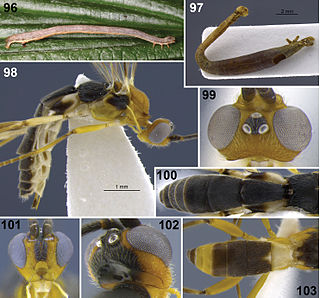
Beatrix "the Bride" Kiddo is the protagonist of the martial arts films Kill Bill: Volume 1 (2003) and Kill Bill: Volume 2 (2004), directed by Quentin Tarantino. She is portrayed by Uma Thurman. In 2010, Entertainment Weekly named the Bride the 99th-greatest character of the preceding 20 years, and in 2015 Empire named her the 23rd-greatest film character of all time.

The Braconidae are a family of parasitoid wasps. After the closely related Ichneumonidae, braconids make up the second-largest family in the order Hymenoptera, with about 17,000 recognized species and many thousands more undescribed. One analysis estimated a total between 30,000 and 50,000, and another provided a narrower estimate between 42,000 and 43,000 species.

Microgastrinae is a subfamily of braconid wasps, encompassing almost 3,000 described species, with an estimated 30,000–50,000 total species. This makes it one of the richest subfamilies with the most species of parasitoid wasps.

The Doryctinae or doryctine wasps are a large subfamily of parasitoid wasps within the family Braconidae.

DNA barcoding is a method of species identification using a short section of DNA from a specific gene or genes. The premise of DNA barcoding is that by comparison with a reference library of such DNA sections, an individual sequence can be used to uniquely identify an organism to species, just as a supermarket scanner uses the familiar black stripes of the UPC barcode to identify an item in its stock against its reference database. These "barcodes" are sometimes used in an effort to identify unknown species or parts of an organism, simply to catalog as many taxa as possible, or to compare with traditional taxonomy in an effort to determine species boundaries.

Hylarana, commonly known as golden-backed frogs, is a genus of true frogs found in tropical Asia. It was formerly considered highly diverse, containing around 84 to 96 valid species, but taxonomic revision resulted in a major change in the contents of the genus, recognizing just four species.

Gaga is a genus of 19 species of ferns in the family Pteridaceae named after American singer and songwriter Lady Gaga. Two of the 19 species are newly-described: Gaga germanotta from Costa Rica, named after the family of the singer, and Gaga monstraparva, in honor of Gaga's fans, whom she calls "little monsters". According to biologists, the ferns bear a close resemblance to Gaga's costume from the 52nd Annual Grammy Awards and also bear a distinct DNA sequence spelling GAGA.

Cystomastacoides kiddo is a species of parasitoid wasp belonging to the family Braconidae. The species was found during a 2006–2008 insect collection programme in Thailand. The name is derived from the character Beatrix Kiddo from the 2003 film Kill Bill, because of their resemblance in action and colour. It is one of the four species under the genus Cystomastacoides, and the only species in Thailand. As all other braconids, the female lays its eggs inside the body of other insects, such as moth caterpillar, so that the larvae use the host body as a source of food.

Cystomastacoides is a genus of parasitoid wasps belonging to the family Braconidae. It was named by Dutch entomologist Kees van Achterberg in 1997 from a single species Cystomastacoides coxalis discovered in Yunnan, China. There are only four species described in the genus, the other three having been reported on 19 March 2013. As typical ichneumon wasps, they are characterised by a deadly parasitoid behaviour. Their larvae grow inside the body of other insects, such as caterpillars, and feed on their internal organs inside the body until they emerge.

Quentin Duane Wheeler is an American entomologist, taxonomist, author and newspaper columnist, and is the founding director of the International Institute for Species Exploration. He was the fourth President of the State University of New York College of Environmental Science and Forestry, in Syracuse, New York until his retirement. Other positions have included: professor of entomology at Cornell University and Arizona State University; Keeper and Head of Entomology at the Natural History Museum in London; and Director of the Division of Environmental Biology at the National Science Foundation.

Bracon is a genus of wasps in the Braconidae, a family of parasitoid wasps. There are several hundred described species but there are thousands still undescribed. The genus is cosmopolitan, distributed throughout the world, with most of the described species occurring in the Palearctic realm.

Dinotrema is a genus of wasps in the family Braconidae. Species are amongst the largest parasitoid wasps in the tribe Alysiini (Alysiinae). There are approximately 350 species described around worldwide.

Aleiodes is a genus of the family Braconidae of parasitoid wasps described by Constantin Wesmael in 1838. They are also known as mummy-wasps.

The Rogadinae are a large subfamily of braconid parasitoid wasps. Several Rogadinae species parasitize pest caterpillars and are important for naturally occurring biological control.

Kaikaia is a genus of treehopper endemic to Nicaragua, containing the single species Kaikaia gaga. It was described in 2020 by Brendan Morris, a Ph.D. student at the University of Illinois at Urbana-Champaign. It entered the news when it was revealed that the insect was named after Lady Gaga.

Netelia producta is a species of ichneumonid wasp in the subfamily Tryphoninae found in Australia.














